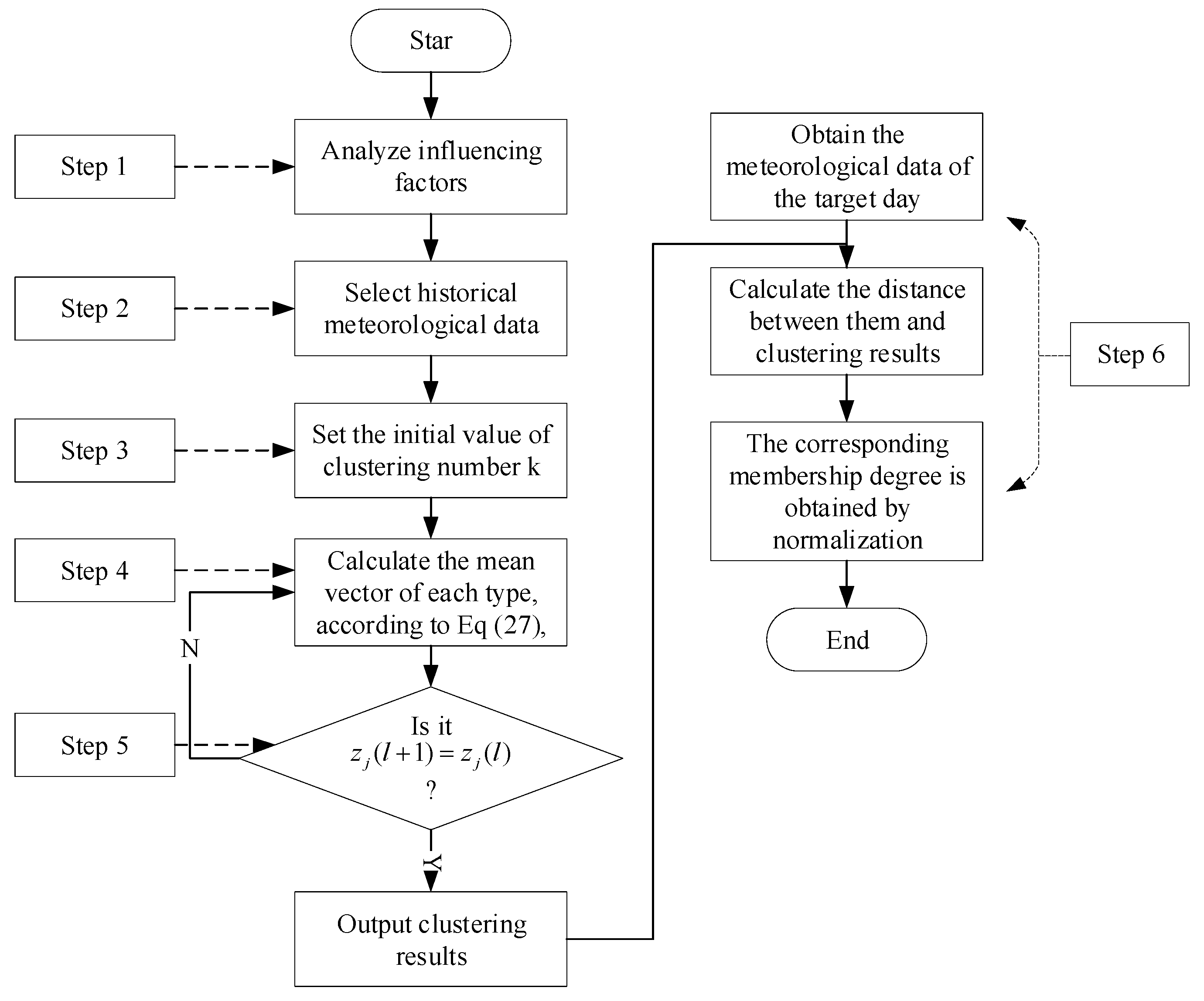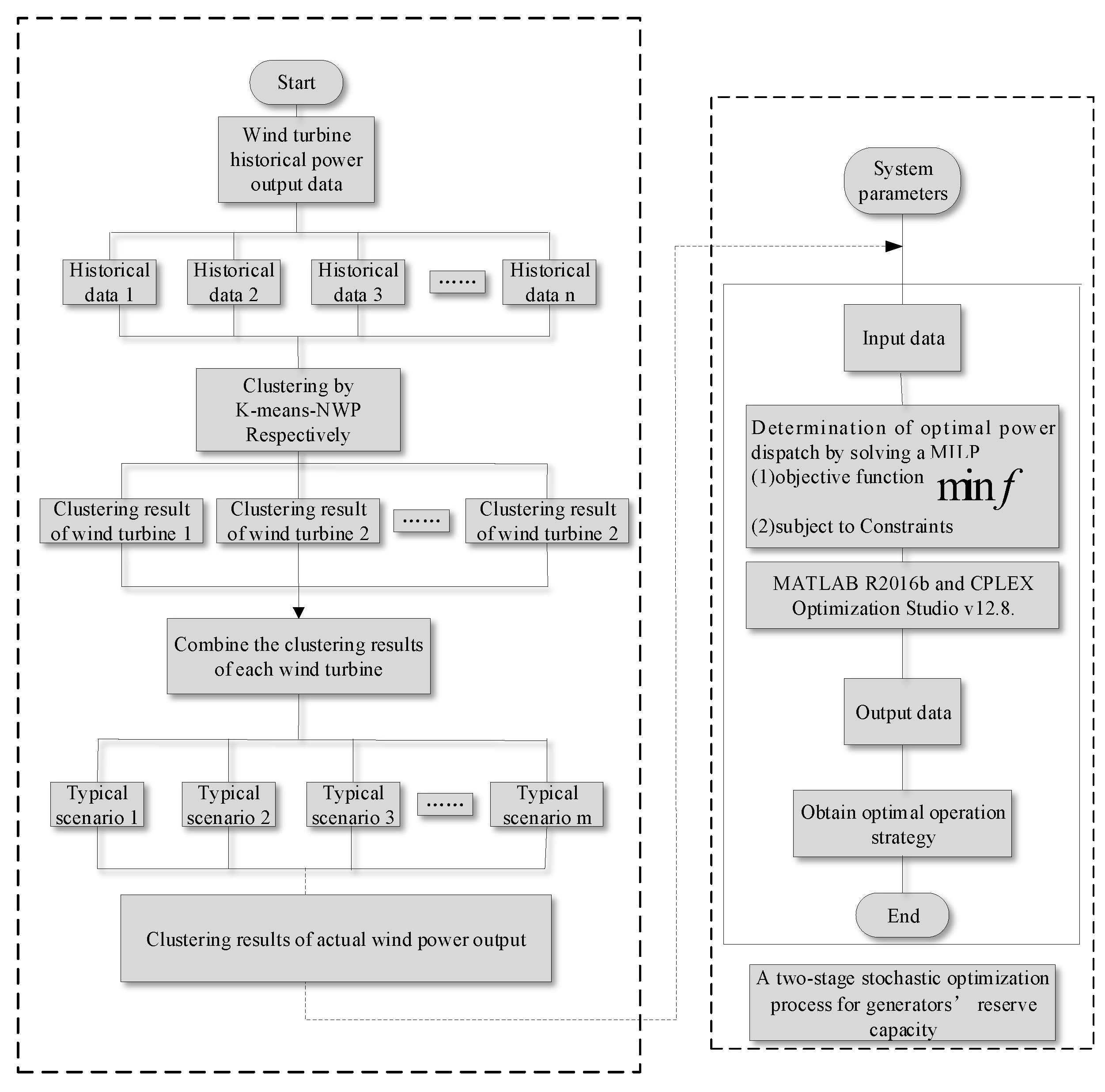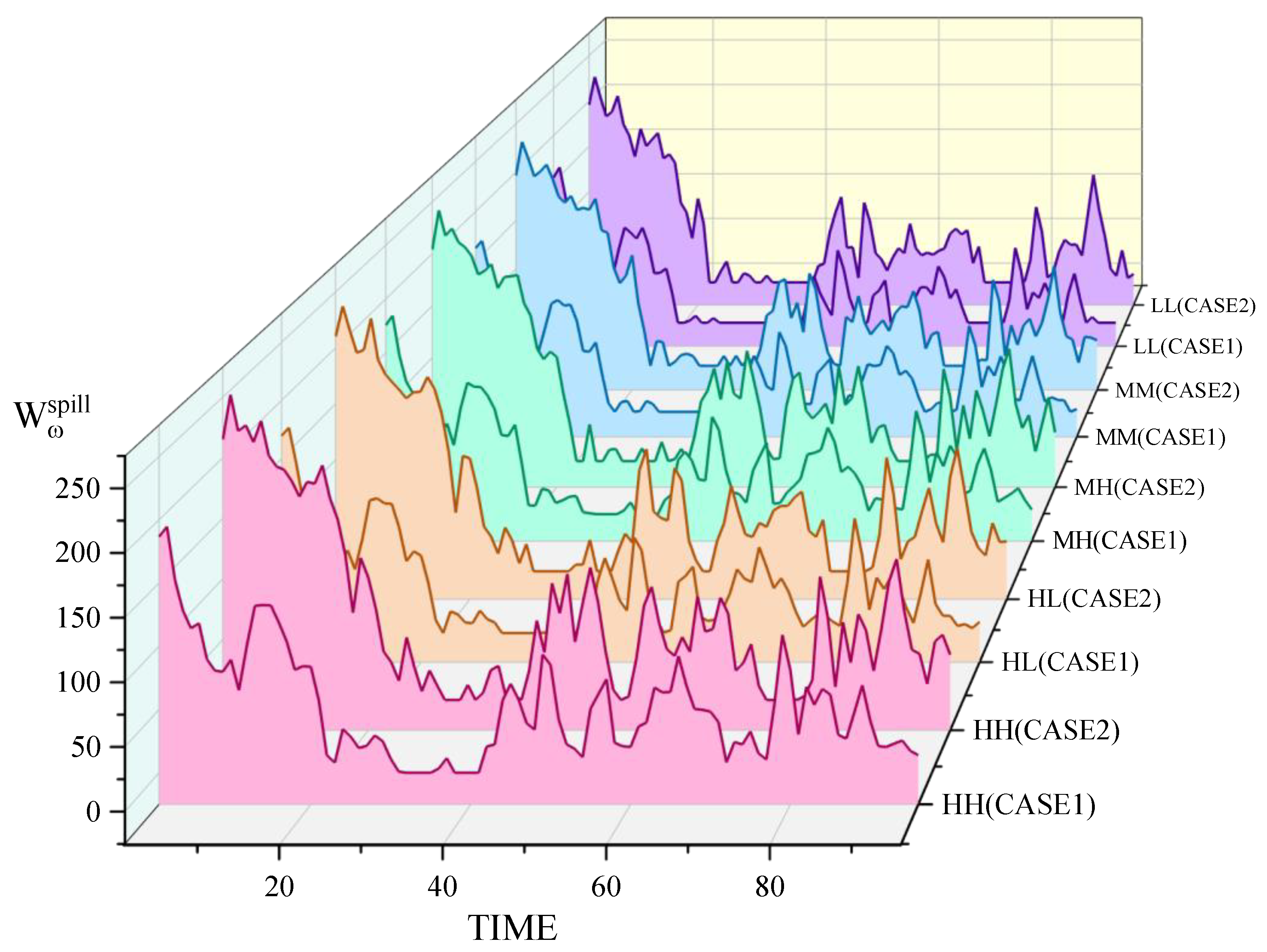1.1. Background and Motivation
With the excessive consumption of fossil energy, energy transformation has been paid attention by all countries worldwide. Renewable energy is favored because of its cleanness, environmental protection, and renewability [
1]. Therefore, renewable energy generation will become the main method of electric energy production in the future. However, these clean energy sources also have some disadvantages. For instance, some kinds of renewable energy supply such as PV (photovoltaic) and wind power, due to the randomness and fluctuation during the generation process, will increase the volatility of system power generation output. What is more, with their large-scale penetration, the uncertainty of market balance will also increase, resulting in the power system operation facing serious challenges. For this reason, countries around the world have not been very effective in large-scale use of clean energy. In China, the utilization efficiency of wind energy is very low, and wind curtailment is a serious problem [
2]. In 2017, the wind curtailment rate in Xinjiang and Gansu province reached 33% and 29% respectively [
3]. Consequently, how to use renewable energy such as wind energy efficiently and reduce spillage of wind power is the main problem to be solved in this paper. Specifically, we further discuss the root cause of wind spillage, and we found that it is mainly the uncertainty of wind in nature that leads to the failure of accurate prediction of wind power output, which leads to the deviation of real-time wind power output, and finally affects the scheduling and production arrangement of the real-time spot market. In order to realize large-scale consumption of wind power, reserve capacity in the real-time stage is necessary, but a free reserve makes power generation companies gradually lose interest [
4]. Therefore, the establishment of a compensation mechanism for reserve capacity will encourage more and more power generation manufacturers to provide more reserve capacity in the real-time stage, offer sufficient reserve space for wind power, and promote wind power consumption.
1.2. Literature Review
With large-scale wind power penetrating into the power system, the significant increase of the frequency modulation (FM) reserve unit is an inevitable trend [
5]. However, considering the uncertainty of wind power, how to reasonably arrange the production of these reserve units is the main issue we need to focus on. In view of this problem, many studies have been done in previous research. The following is an overview of the methodology used by predecessors’ studies to solve this problem.
For the uncertainty processing of wind power, most of the processing methods adopted in the previous research can be divided into two categories, namely robust optimization and stochastic optimization. References [
6,
7,
8,
9,
10] adopt the idea of robust optimization to cope with the volatility of wind power. Reference [
6] studies the wind power uncertainty of gas-electric integrated system coordination optimization and puts forward a two-stage distributionally robust optimization (DRO) model with the goal of minimum system total operating cost to analyze the impact of residents of gas load, abandon the wind punishment cost coefficient, and climb rate parameters on the final optimization results. Based on robust optimization, the literature [
7] establishes an optimization model for joint scheduling of energy and auxiliary services markets that considered wind power uncertainty in the real-time power market and proposes redundant constraint reduction strategy to improve the computational efficiency of robust joint scheduling. Reference [
8] utilizes distributionally robust chance constrained and interval optimization to handle the impact of wind power fluctuation. In reference [
9], a robust unit commitment model with multi objectives (minimizing the operating cost and maximizing the peak shaving capacity of the power system) is proposed to resist the disturbance of wind power stochastic fluctuation. In addition, reference [
10] utilizes robust optimization to deal with the uncertainty of wind power and photovoltaic power output, and the Gaussian process method is used to predict the confidence interval of uncertain parameters, which support a day-ahead market scheduling strategy formulation. However, both robust optimization and distributionally robust optimization have drawbacks, which are that scheduling decisions are too conservative and at the expense of economic interests.
Therefore, stochastic optimization, another method to solve uncertain problems, is favored by researchers. Reference [
11] formulates a stochastic optimization model to accomplish the day-ahead economic dispatch fully considered wind power volatility. In reference [
12], a scheduling model for the coordinated operation of hydro and wind power is established by utilizing the complementary characteristics of hydro and wind energy, and a stochastic programming model is adopted to cope with the uncertainty of wind power output. In addition, reference [
13], in considering the influence of solar radiation intensity and wind power uncertainty on the whole scheduling process, establishes a stochastic optimal scheduling model for centralized wind-solar power stations. Moreover, a day-ahead stochastic scheduling model of thermal-hydro-wind-photovoltaic power system is presented in reference [
14], which adopts Monte Carlo simulation to generate the output scenarios of wind power and photovoltaic power to describe their uncertainty. Yet all of the above studies did not consider the impact of wind power uncertainty on the power system concretely. Specifically, wind power in the electricity spot market is divided into two stages, i.e., the first stage is day-ahead market dispatch phase, and the second stage is a real-time market, whereas the actual deviation of the wind power output often occurs in the second stage. Therefore, the established stochastic programming model divided into two stages should be taken into account, which can restore the real-time situation of actual scheduling.
Generally, the consumption of wind power not only considers the reserve capacity market but also other methods to realize the safe and reliable connection of wind power to the grid. For example, demand response management (DRM) [
15], joint operation of energy storage units, and other cooperative operation mechanism can balance the deviation of wind power real-time output. However, many researchers tend to consider these in terms of reserve capacity and ignore other approaches that can also promote wind power consumption. In reference [
16], a dynamic economic scheduling model of integrated power system contained wind power is proposed to optimize the generation and reserve capacity of all units, and the capacity and ramp rate of the generator have an important impact on the optimal scheduling of reserve capacity, but the demand response of the user side is not mentioned. What is more, reference [
17] introduces the concept of interruptible load and presents a cost-benefit tradeoff-based algorithm for optimal reserve capacity in the power market, which emphasized that both generator sets and interruptible load could participate in the reserve market. In addition, some of the literature also adopts the joint operation of energy storage device and wind turbine to reduce the interference of wind power instability on the system [
18,
19,
20]. For instance, reference [
18] proposes a wind power, pumped storage, and thermal plant joint operation mechanism with the objective of maximizing the operator’s profit gained from the day-ahead market and reserve market, and a heuristic optimization algorithm has been used to solve this problem. In reference [
19], a combination of wind turbines and air compression energy storage devices is introduced. Similar to reference [
18], reference [
20] also presents a decision-making mechanism for wind-energy storage joint system to participate in day-ahead market and reserve market. In summary, it can be found that the research on the scheduling mechanism of DRM as a flexible resource to balance wind power is relatively weak. Consequently, it is necessary to fill the research gap in this field.
According to the summary of the above literature review, it can be obviously concluded that previous research still has three insufficiencies. First of all, in terms of research methods, most of them adopt the idea of robust optimization, which leads to the over-conservative results. Second, the traditional stochastic optimization process cannot fully reflect the actual scheduling process when dealing with the uncertainty of wind power. Finally, on the demand side, the utilization of flexible demand response resources is insufficient.
1.3. Contributions and Organization
To fill the research gap, this paper proposes a novel two-stage stochastic optimization model for a wind power system with the participation of spot market, which considers both the flexibility of supply side and demand side, that is, the flexibility capacity includes interruptible load of demand response and reserve capacity of thermal power unit. The promotion effect of adding flexible capacity market in the real-time stage on the consumption of clean energy is fully studied, and the consumption situation of wind power is further analyzed. Additionally, the main contributions of this paper can be divided into three aspects. First, the model is constructed to establish a compensation mechanism when standby power is invoked in the real-time stage. Second, a two-stage stochastic optimization method is used to set up the scheduling optimization model, and the clustering method K-means-NWP is adopted to describe the uncertainty of wind power output. Finally, the flexibility of adjusting resources based on demand response is considered, which can increase the reserve power of the system and improve the consumption capacity of wind power.
Besides, the organization of the remaining sections are as follows:
Section 2 elaborates the main problems studied in this paper; in the
Section 3, the mathematical model is built and the solution method is given;
Section 4 uses a numerical example to verify the rationality of the established model; and the final conclusions are given in
Section 5.











